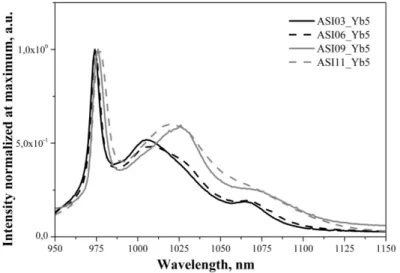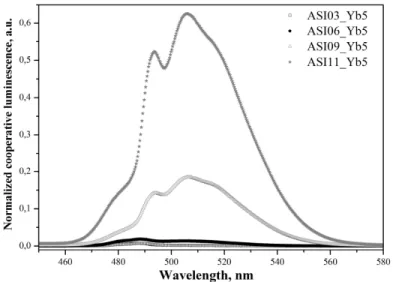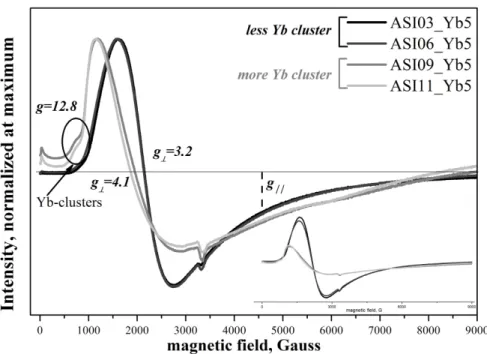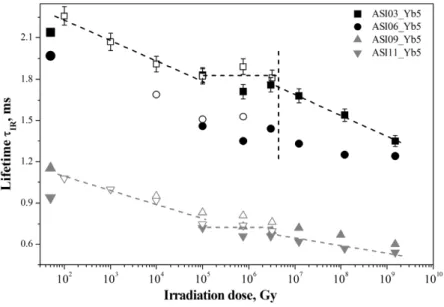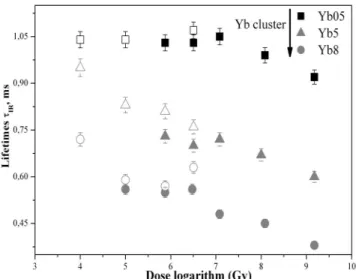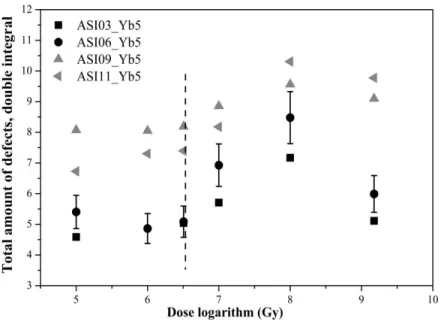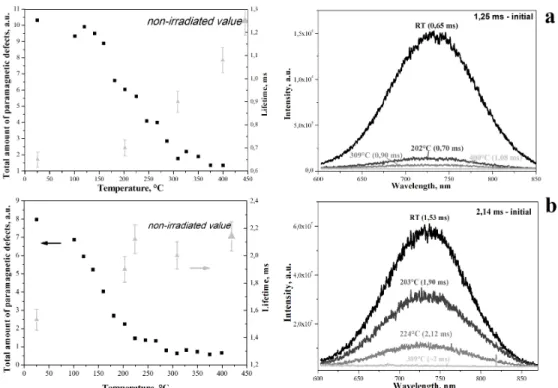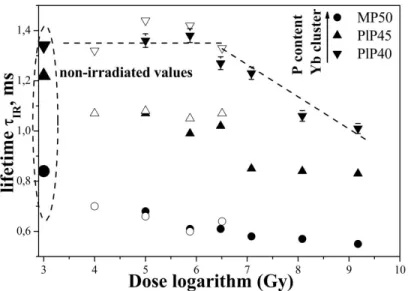HAL Id: hal-01275486
https://hal.sorbonne-universite.fr/hal-01275486
Submitted on 17 Feb 2016
HAL is a multi-disciplinary open access archive for the deposit and dissemination of sci-entific research documents, whether they are pub-lished or not. The documents may come from teaching and research institutions in France or abroad, or from public or private research centers.
L’archive ouverte pluridisciplinaire HAL, est destinée au dépôt et à la diffusion de documents scientifiques de niveau recherche, publiés ou non, émanant des établissements d’enseignement et de recherche français ou étrangers, des laboratoires publics ou privés.
Impact of rare earth element clusters on the excited
state lifetime evolution under irradiation in oxide glasses
Vera Pukhkaya, Philippe Goldner, Alban Ferrier, Nadège Ollier
To cite this version:
Vera Pukhkaya, Philippe Goldner, Alban Ferrier, Nadège Ollier. Impact of rare earth element clusters on the excited state lifetime evolution under irradiation in oxide glasses. Optics Express, Optical Society of America - OSA Publishing, 2015, 23 (3), pp.3270-3281. �10.1364/OE.23.003270�. �hal-01275486�
Impact of rare earth element clusters on the
excited state lifetime evolution under irradiation
in oxide glasses
Vera Pukhkaya1, Philippe Goldner,2 Alban Ferrier2,3 and Nadège Ollier1*
1Laboratoire des Solides Irradiés, UMR 7642 CEA-CNRS-Ecole Polytechnique, Palaiseau, France 2PSL Research University, Chimie ParisTech - CNRS, Institut de Recherche de Chimie Paris, 75005, Paris, France
3Sorbonne Universités, UPMC Univ Paris 06, 75005, Paris, France
*nadege.ollier@polytechnique.edu
Abstract: Rare earth doped active glasses and fibers can be exposed to
ionizing radiations in space and nuclear applications. In this work, we analyze the evolution of 2F
5/2 excited state lifetime in Yb3+ ions in irradiated
aluminosilicate glasses by electrons and γ rays. It is found that the variation of lifetimes depends on the Yb3+ clusters content of the glasses for
irradiation doses in the 102 – 1.5·109 Gy range. In particular, glasses with
high clustering show a smaller decrease in lifetime with increasing radiation dose. This behavior is well correlated to the variation in paramagnetic defects concentration determined by electron paramagnetic resonance. This effect is also observed in Yb3+ doped phosphate and Er3+ doped
aluminosilicate glasses, inferring that clustering plays an important role in irradiation induced quenching.
©2015 Optical Society of America
OCIS codes: (140.3615) Lasers, ytterbium; (160.5690) Rare-earth-doped materials; (160.2750) Glass and other amorphous materials; (260.3800) Luminescence; (350.5610) Radiation. References and links
1. P. Barua, E. H. Sekiya, K. Saito, and A. J. Ikushima, “Influence of Yb3+ ion concentration on the spectroscopic
properties of silica glass,” J. Non-Cryst. Solids 354(42-44), 4760–4764 (2008).
2. B. Schaudel, P. Goldner, M. Prassas, and F. Auzel, “Cooperative luminescence as a probe of clustering in Yb3+
doped glasses,” J. Alloy. Comp. 300–301, 443–449 (2000).
3. P. Goldner, B. Schaudel, and M. Prassas, “Dependence of cooperative luminescence intensity on Yb3+ spatial distribution in crystals and glasses,” Phys. Rev. B 65(5), 054103 (2002).
4. S. Girard, M. Vivona, A. Laurent, B. Cadier, C. Marcandella, T. Robin, E. Pinsard, A. Boukenter, and Y. Ouerdane, “Radiation hardening techniques for Er/Yb doped optical fibers and amplifiers for space application,” Opt. Express 20(8), 8457–8465 (2012).
5. N. Ollier, J.-L. Doualan, V. Pukhkaya, T. Charpentier, R. Moncorgé, and S. Sen, “Evolution of Yb3+
environment and luminescence properties under ionizing irradiation in aluminoborosilicate glasses,” J. Non-Cryst. Solids 357(3), 1037–1043 (2011).
6. B. Tortech, Ph. D. dissertation, Saint-Etienne, (2008).
7. B. Tortech, Y. Ouerdane, S. Girard, J.-P. Meunier, A. Boukenter, T. Robin, B. Cadier, and P. Crochet, “Radiation effects on Yb- and Er/Yb-doped optical fibers: a micro-luminescence study,” J. Non-Cryst. Solids 355(18-21), 1085–1088 (2009).
8. A. Polman and J. M. Poate, “Ion irradiation damage in Er-doped silica probed by the Er3+ luminescence lifetime
at 1.535 µm,” J. Appl. Phys. 73(4), 1669–1674 (1993).
9. V. Pukhkaya, T. Charpentier, and N. Ollier, “Study of formation and sequential relaxation of paramagnetic point defects in electron-irradiated Na-aluminosilicate glasses: influence of Yb,” J. Non-Cryst. Solids 364, 1–8 (2013). 10. B. Schaudel Ph, D dissertation, Paris 6, (2000)
11. S. Sen, R. Rakhmatullin, R. Gubaidullin, and A. Pöppl, “Direct spectroscopic observation of the atomic-scale mechanisms of sluctering and homogenization of rare-earth dopant ions in vitreous silica,” Phys. Rev. B 74(10), 100201 (2006).
12. N. Ollier, R. Planchais, and B. Boizot, “EPR study of Yb-doped irradiated glasses” Nucl. Instr. and Meth. in Phys. Res. B, 266, 2854–2858, (2008).
13. L. Skuja, “Optically active oxygen-deficiency-related centers in amorphous silicaon dioxide,” J. Non-Cryst. Solids 239(1-3), 16–48 (1998).
14. P. D. Dragic, C. G. Carlson, and A. Croteau, “Characterization of defect luminescence in Yb doped silica fibers: part I NBOHC,” Opt. Express 16(7), 4688–4697 (2008).
1. Introduction
Yb3+ ion is an essential dopant in glasses and fibers for IR-lasers due to its highly-efficient
emission at ~1 µm. Owing to its unusual energy level scheme with only two manifolds separated by about 10000 cm−1, Yb3+ offers interesting spectroscopic properties for optical
applications such as absence of excited state absorption and relatively long emission lifetime. The lifetime of Yb3+ excited state 2F
5/2 is an important spectroscopic parameter because it
determines the laser pump saturation intensity Isat ~1/τIR which should be as low as possible
[1].
To increase the IR-laser gain, Yb3+ concentration can be increased but results in the
formation of clusters, especially in pure SiO2 glasses where the network rigidity is not
suitable to host a high content of rare earth ions. In glasses containing modifier ions, the local environment of Yb3+ ions is defined preferentially by Non-Bridging Oxygens. Their
concentration impacts the Yb clusters content in oxide glasses as was demonstrated in aluminosilicate, phosphate and aluminoborosilicate glasses [2, 3].
Active fibers such as Yb3+ or Er3+ doped ones can be exposed to ionizing radiations in
nuclear or space applications [4]. Besides quantifying the Radiation Induced Absorption (RIA) and analyzing the corresponding point defects, it is also necessary to estimate the influence of ionizing radiations on rare earth element spectroscopic properties in these fibers. Only a few papers have reported such studies up to now. It has been shown that ionizing radiations (electron, γ rays) can affect Yb3+ spectroscopic properties in aluminoborosilicate
glasses such as the 2F
5/2 excited state lifetime and the cooperative emission intensity [5]. This
was correlated to the formation of hole centers type defect under irradiation, in this case, Non-Bridging Oxygen Hole Centers (NBOHC) [5]. In Er-doped fibers, a similar decrease of
4I
13/2 lifetime has been observed under γ-irradiation [6, 7] and ion radiation [8]. This was
attributed to non-radiative energy transfers from the 4I
13/2 level to radiation-induced point
defects [6, 7].
In the present study, we investigate the evolution of Yb3+ exited state lifetime under
ionizing radiations (electrons, γ rays) for a broad dose range (102-109 Gy) in a series of
aluminosilicate glasses. The composition of these glasses was chosen to study the influence of Yb3+ clustering on spectroscopic changes. This was motivated by our previous observation of
Yb3+ clustering impact on the thermal recovery of radiation induced paramagnetic point
defects [9]. Here, we show that Yb3+ excited state lifetime decreases at a lower rate as a
function of the irradiation dose in glasses with high clusters amount. A good agreement is also found with the variation of the defect concentration in these glasses. The same excited state lifetime evolution is also observed in Yb3+ doped phosphate glasses and Er3+ doped
aluminosilicate glasses, suggesting that this behavior is independent on the particular rare earth-glass combination.
2. Experimental details
Four Yb-doped and two Er-containing aluminosilicate glass compositions were synthesized. For that, appropriate amounts of dried powders of SiO2, Al2O3, Na2CO3 Yb2O3 or Er2O3 were
mixed thoroughly to obtain a well-homogenized powder and slowly heated (during 10 hours) in a Pt-Au crucible from room temperature up to 1600°C (melting temperature) in a furnace under air during 4 hours. Slow heating facilitated the CO2 release process taking place at
~800°C. In addition, it promoted higher homogeneity of the melt. Afterwards, glasses were quenched at room temperature and annealed at 580°C (below Tg) in order to reduce the
residual thermal stresses. The nominal aluminosilicate glass compositions are presented in Table 1. Samples are labeled according to the Aluminum Saturation Index (ASI = Al/Na), which characterizes the Non-Bridging Oxygen concentration. Actual glass compositions were
determined with microprobe analysis giving <1 mol. % of error compared to nominal compositions.
Phosphate glass samples were prepared starting from NH4H2PO4, MgO, Na2CO3 and
Yb2O3 (5 wt. %). The initial powders were mixed and melted in a silica crucible and then
slowly heated from room temperature up to 900°C. As in the case of aluminosilicate glasses, slow heating favored CO2 release and homogenization. The melted glass was quenched
rapidly into a Pt-Au crucible on an electric plate at 300°C to avoid a high cooling rate, and immediately annealed at 350°C to reduce residual thermal stresses. The nominal phosphate glass compositions are presented in Table 2.
Table 1. Nominal Yb3+ and Er3+- doped Aluminosilicate Glass Compositions
Sample name SiO2,
mol. % Al2O3, mol. % Na2O, mol. % ASI Al/Na ASI03_Yb5 74 6 20 0.3 + 5 wt. % Yb2O3 ASI06_Yb5 68 12 20 0.6 ASI09_Yb5 62 18 20 0.9 ASI11_Yb5 58 22 20 1.1 ASI09_Yb05 62 18 20 0.9 + 0.5 wt. % Yb2O3 ASI09_Yb8 + 8 wt. % Yb2O3 ASI03_Er 74 6 20 0.3 + 0.5 wt. % Er2O3 ASI09_Er 62 18 20 0.9 + 0.5 wt. % Er2O3
Bulk glass samples (5 × 5 mm2, 500-700 µm thickness) were continuously irradiated at
SIRIUS electron accelerator (Laboratoire des Solides Irradiés, Palaiseau, France) with the 2.5 MeV electron beam with a dose rate close to 25 MGy/h. The sample holder was maintained around 40°C with a water-cooling system. The achieved integrated doses were 105, 106, 3·106,
107, 108 and 1.5·109 Gy. Samples were also irradiated with γ-rays of 1.25 MeV from Co60
source in “Centre National des Sciences et Technologies Nucléaires” in Tunisia (CNSTN). The dose rate in this case was 5.64 kGy/h. The achieved doses were 104, 105, 106 and 3·106
Gy. Two lower doses 100 Gy and 1000 Gy were achieved with γ-rays of 1.25 MeV from Co60
source in “Institut de Radioprotection et de Sûreté Nucléaire” (IRSN, Fontenay-aux-Roses, France). The dose rate was 2 Gy/min. The error bar on the radiation dose after electron irradiation is considered as 10% because of the backscattered electrons that were not taken into account in the dose calculation”. Concerning gamma rays irradiation, at 100 Gy the error is 5.5%.
Table 2. Nominal Yb3+-doped Phosphate Glass Compositions
Sample name P2O5, mol. % MgO, mol. % Na2O, mol. % MP50 50 16.7 33.3 + 5 wt.% Yb2O3 PlP45 45.4 18.2 36.4 PlP40 40 20 40 Yb3+ emission 2F
5/2→2F7/2 in the IR-region was recorded on a HORIBA Jobin Yvon
spectrofluorimeter under Xe lamp excitation at 975 nm with a 1200 gr/mm grating and a RG-830 filter. The lifetime of Yb3+ excited state 2F
5/2 was measured at 1000 nm with a time
resolution of 100 µs. The lifetime of Er3+ 4I
13/2 excited state was measured using pulsed laser
excitation at 975 nm (Ekspla optical parametric oscillator NT342B) and detection by an InGaAs detector. Yb3+ cooperative luminescence was excited at 975 nm by a laser diode,
dispersed by a Jobin-Yvon H25 spectrometer and detected by a photon counting photomultiplier tube. In order to perform accurate cooperative luminescence measurements, the samples were grounded into powders of well-controlled particle size in the range 100-125 µm [2].
Electron Paramagnetic Resonance (EPR) experiments were carried out on a Bruker X-band EMX spectrometer. Paramagnetic point defects were analyzed at room temperature and Yb3+ signal was recorded at 4K. The microwave frequency was 9.8 GHz. Spectra were
normalized by attenuator gain and sample mass to allow quantitative comparisons. Radiation-induced point defects were also analyzed by time-resolved photoluminescence at room temperature. We used a frequency-doubled pulsed Nd:YAG laser for excitation and a Shamrock SR-303i spectrometer and an ANDOR ICCD camera for detection. The delay was 500 ns and the gate width was 100 µs.
3. Results and discussion
3.1 Yb3+ doped aluminosilicate glasses
3.1.1 Optical and EPR spectroscopy of non-irradiated samples
The lifetimes τIR of 2F5/2 Yb3+ excited state in non-irradiated aluminosilicate glasses are
displayed in Table 3. Although the concentration of Yb3+ was maintained at 5 wt. % of
Yb2O3, we observed that τIR decreased from 2.14 ms in ASI03_Yb5 glass to 0.94 ms in
ASI11_Yb5 glass. We attribute this to changes in Yb3+ environment in the different glasses,
resulting in variations of the 2F
5/2→2F7/2 transition oscillator strength [10].
Table 3. Yb3+ 2F
5/2 Lifetimes in Non-irradiated Aluminosilicate Glasses
Glass sample 2F 5/2 lifetime (ms) ASI03_Yb5 2.14 ASI06_Yb5 1.97 ASI09_Yb5 1.15 ASI11_Yb5 0.94
Yb3+ environment changes are also clearly seen in the normalized emission spectra shown
in Fig. 1. In particular, the peak located at 1006 nm in ASI03_Yb5 and ASI06_Yb5 shifts to 1027 nm in ASI09_Yb5 and ASI11_Yb5 glasses. This could reflect a larger Stark splitting in the latter glasses due to a stronger crystal field. These changes in Yb3+ environment were
confirmed by EPR spectroscopy (see below).
Fig. 1. Normalized Yb3+ emission spectra in non-irradiated Yb3+ doped aluminosilicate glasses
under 975 nm excitation.
Yb3+ clustering was probed by cooperative luminescence [2]. Corresponding spectra for
non-irradiated glasses are shown in Fig. 2. Spectra were normalized by the factor (αD*τIR)2,
where αD is the absorption coefficient calculated by integrating the product of the absorption
spectrum of the sample by the emission spectrum of the diode (normalized at maximum). Since excitation absorption was low in the powder geometry, the cooperative emission probability, which reflects Yb3+ cluster concentration, was proportional to the area under the
normalized cooperative emission spectra [3]. The cooperative emission probability increases strongly from ASI03_Yb5 glass to ASI11_Yb5 (Fig. 2) and the glass series can be divided into two groups: ASI03_Yb5-ASI06_Yb5 (low Yb3+ cluster amount) and ASI09_Yb5-
ASI11_Yb5 (high Yb3+ cluster amount). The high clustering in ASI09 and ASI11 glass
compositions can be explained by a lower amount of NBO due to an increasing Al3+ content
that must be compensated by Na+ ions [2]. We checked by MAS NMR of 27Al the fourfold
coordination of Al3+ in those glasses [9] in order to exclude any modifications of Al3+
coordination number.
Fig. 2. Normalized cooperative luminescence spectra of non-irradiated Yb-doped aluminosilicate glasses.
To further probe Yb3+ environment and clustering, EPR spectra were recorded at 4K (Fig.
3). The broad line in the whole range of magnetic field corresponds to well-diluted Yb3+ ions
in glass [5, 11, 12]. In ASI09_Yb5 and ASI11_Yb5 glasses, the EPR signal is much lower despite the same amount of Yb3+ in all four glasses (Fig. 3, inset). This decrease indicates that
part of Yb3+ ions is not detected, probably because of too short spin relaxation time T 1. This
can be due to the formation of Yb3+ ion clusters [11], in agreement with the cooperative
luminescence results. Besides, in both glasses, a shoulder at g = 12.8 can be seen, which we assign to Yb3+ clusters [16]. Indeed, the theoretical g-value for isolated Yb3+ ions does not
exceed 2Λ·Μ where Μ is the maximum of the projection of the total angular momentum and Λ is the Landé factor. The ground multiplet of Yb3+ is 2F
7/2, corresponding to Λ = 8/7 and Μ = 7/
2. Thus, gmax~8 for isolated Yb3+ ions [11], suggesting that the g = 12.8 shoulder corresponds
to clusters.
Yb3+ EPR spectra were analyzed in more details by assuming an axial site symmetry.
Determining the exact parameters of the g-tensor is difficult in glasses because of inhomogeneous broadening. The value of g┴ is estimated to 3.2 in ASI03_Yb5 and
ASI06_Yb5 and 4.1 in ASI09_Yb5 and ASI11_Yb5 glasses. We did not perform simulations to obtain g║ parameters but we estimate g║ ~1.3-1.4 in ASI03_Yb5 and ASI06_Yb5 and g║
~1.1 in ASI09_Yb5 and ASI11_Yb5. The variation in g┴ with glass composition is in
agreement with the emission spectra and reflects different environments for Yb3+ ions in low
and high ASI index glasses. It should also be noted that the g┴ factors obtained in Yb-doped
aluminoborosilicate (ABS) glasses with low clustering content were in the range 3.17 to 3.32 [12], close to the values found here for ASI03_Yb5 and ASI06_Yb5, in which clustering is low too.
Fig. 3. EPR spectra normalized at maximum signal of non-irradiated Yb-doped aluminosilicate glasses (T = 4K). Inset: normalization by mass and gain only.
3.1.2 Evolution of Yb3+ 2F
5/2 lifetime under irradiation in aluminosilicate glasses
First, we studied the evolution of lifetimes after irradiation for delays up to 4 months. Despite irradiation, all fluorescence decays were well fitted by a single exponential. Figure 4 displays the obtained τIR values in irradiated glasses at 105 Gy at different times after irradiation. The
values before irradiation are labeled by larger symbols. In all samples, irradiation results in a clear decrease (40-50%) of the 2F
5/2 lifetime. Then, for glasses ASI09_Yb5 and ASI11_Yb5
there is almost no variation of τIR for delays up to 4 months. In opposition, for glasses
ASI03_Yb5 and ASI06_Yb5, one can observe a slight increase of the τIR. In all glasses, the
lifetime of Yb3+ excited state 2F
5/2 did not reach its pre-irradiation value on the time scale
investigated.
Fig. 4. 2F
5/2 lifetimes of Yb3+ excited state recorded at different times after electron irradiation
This behavior can be understood by considering that the 2F
5/2 level is quenched by the
defects induced by the irradiation. Indeed, the concentration of paramagnetic point defects induced by irradiation decreases with time, with a slower rate in glasses with higher Yb3+
clustering [9]. This is explained by the ability of clustered Yb3+ ions to efficiently trap
charges under a stable form during the irradiation process. As a consequence, point defects thermal recovery is slowed down, as its τIR increase.
We also analyzed the dose effect on τIR lifetime after 6 months to reach stable values.
Figure 5 displays τIR as a function of lg(dose) obtained for both electron and gamma
irradiation. First, we see that irradiation at 100 Gy has no impact on the 2F
5/2 lifetime in
glasses with high or low Yb3+ cluster content. The first effect can be seen at 1000 Gy. This
result is meaningful for space applications where cumulated doses reach 300 Gy in 10 years, although the dose rate is much lower than the one used in our experiments. Consequently a direct extrapolation of this result to space application is not straightforward.
Fig. 5. 2F
5/2 lifetimes for e- and γ irradiated Yb3+-doped aluminosilicate glasses (measured 6
months after irradiation). Solid (open) symbols: electron (gamma) irradiation; larger symbols: non-irradiated values. Error bars are shown for ASI03_Yb5 glasses only for easier reading.
For glasses with lower ASI parameters – ASI03_Yb5 and ASI06_Yb5 – in both the lower dose range (<105Gy) and in the higher dose range (>3·106Gy) clear linear decrease is seen
(Fig. 5). However, little or no variation occurs in the 105– 3·106Gy dose range. In contrast, for
the other two glass compositions with higher ASI parameter, the linear variation in lifetime τIR presents smaller slopes in the lower and stronger doses regions and there is little evidence
for a plateau in the 105– 3·106 Gy dose range.
We also observed no difference in lifetimes between e¯- and γ-irradiated glasses (Fig. 5). This indicates that the concentration and nature of the defects involved in 2F5/2 quenching are
similar in both cases, in the limit of our observations (three dose levels).
The τIR lifetime evolution was further analyzed in ASI09 aluminosilicate glasses doped
with various Yb3+ concentrations: 0.5, 5 and 8 wt. % (Fig. 6). At low Yb3+ concentration, the
behavior of low clustering glasses ASI03 and ASI06 is reproduced, whereas at high Yb3+
concentration, the lifetime evolution follows that of ASI09 and ASI011. Taking into account that we checked that clustering is increasing with increasing Yb3+ concentration, we conclude
that Yb3+ clustering, and not glass composition, modifies the evolution of τ
IR as a function of
Fig. 6. Variation of the 2F
5/2 decay time value of Yb3+ as a function of the logarithmic dose.
The irradiation has been performed with e¯-on aluminosilicate glasses ASI09_Ybx with different Yb concentration. Empty symbols are used for gamma irradiation
3.1.3 Correlation between 2F
5/2 lifetime and radiation-induced point defects
In order to understand the 2F
5/2 lifetime variation, we measured the paramagnetic point defects
nature and concentration, and their evolution under an annealing treatment. Figure 7 displays the total amount of paramagnetic point defects as a function of irradiation dose. This was determined from double integration of the EPR spectra in the g = 2 region [9]. A plateau (105
-3·106Gy) is followed by an increase of defects with increasing dose, and then further followed
by a decrease at the highest radiation exposure level. Moreover, glasses with the higher cluster content (ASI09_Yb5 and ASI11_Yb5) show a smaller variation of defects concentration with dose. This is in qualitative agreement with the limited 2F
5/2 lifetime
variation with irradiation dose (Fig. 5). For glasses with lower clustering (ASI03_Yb5 and ASI06_Yb5), a similar correlation is observed.
Fig. 7. Total amount of paramagnetic point defects in irradiated Yb3+-doped aluminosilicate
glasses.
In order to examine the possible role of particular point defects in lifetime decrease, we carried out annealing treatments on two Yb3+-doped aluminosilicate glasses with opposite
Yb3+ cluster content: ASI03_Yb5 and ASI09_Yb5. As a matter of fact, bleaching temperature
is unique for each defect since it is associated to its energy activation, so an annealing treatment is a tool to separate defect contribution.
The total defect concentration of two Yb3+-doped aluminosilicate glasses as a function of
annealing temperatures is presented in Fig. 8. The precise analysis of paramagnetic defect in those glasses was reported in details elsewhere [9]. In ASI03_Yb5, the lifetime of Yb3+
excited state 2F
5/2 is already back to its pre-irradiation value ~2.14 ms after annealing at 244
°C [Fig. 8(b)]. However, there are still defects in the glass, which are partly identified as HC type (HC1 and HC2) from the EPR spectrum [9]. Moreover, at the same temperature, we observed under 532 nm laser excitation, a broad band centered at 725 nm that we attribute to NBOHC [Fig. 8(b)]. Even if the position is deviated from 620 nm as in SiO2 glass [13], we
assume that the presence of Al can lead a red-shift the position band [14]. We conclude from these results that neither HC defects nor NBOHC defects are solely responsible for the decrease of the 2F
Fig. 8. 2F
5/2 lifetimes and total concentration of paramagnetic defects (left), and
photoluminescence spectra of NBOHC (right) in ASI09_Yb5 (a) and ASI03_Yb5 (b) glasses obtained after annealing at various temperatures. Electron irradiation at 108 Gy.
Contrary to ASI03_Yb5, τIR in ASI09_Yb5 is not back to the pre-irradiation value after
annealing at 400°C [Fig. 8(a)]. At this temperature, peroxy radicals were evidenced by EPR, whereas neither Al-OHC nor NBOHC defects were detected [Fig. 8(b)]. As the absorption band of peroxy radicals centered at 1.97 eV (630 nm) [13] extends to Yb3+ emission range,
they could be responsible for the decrease of 2F
5/2 lifetime.
3.2 Extension to other systems
We first studied 2F
5/2 lifetime as a function of irradiation dose and cluster content in Yb3+
doped phosphate glasses. As in aluminosilicate glasses, one can observe a multi-step τIR
variation in poly-phosphate glasses, in which the cluster amount is low (Fig. 9), opposed to a monotonically decrease in meta-phosphate glasses with higher Yb3+ clustering. The cluster
concentration was determined by cooperative luminescence [2]. This result on phosphate glasses first confirms the role of clusters and second suggests that lifetime behavior is irrelevant to the glass composition and consequently on the type of point defect formed.
Fig. 9. 2F
5/2 lifetimes of Yb3+ doped- phosphate glasses.
We also investigated Er3+ doped glasses, in order to further assess the role of clusters.
Figure 10 displays the lifetime of 4I
13/2 excited state in ASI03 and ASI09 glasses as a function
of lg(dose). In ASI03_Er05 glass with low Er3+ cluster content, the 4I
13/2 lifetime evolution is
similar to that of glasses with low Yb3+ cluster content, whereas in ASI09_Er05 glass the
lifetime variation is lower, as in high Yb3+ clustering glasses (see Fig. 5). This suggests that
the de-excitation channels via point defect formation are similar for Yb3+ and Er3+ ions.
Fig. 10. 4I
13/2 lifetimes of Er3+ doped-aluminosilicate glasses.
4. Conclusion
We have studied Yb3+ doped aluminosilicate glasses with varying clusters content, which was
evidenced by cooperative luminescence and EPR spectroscopy. Yb3+ excited state lifetime
was recorded as a function of irradiation dose in a 102-1.5⋅109 Gy range (electron and γ rays)
and delays after a 105 Gy dose irradiation. Ionizing radiations were found to decrease
lifetimes with rates depending primarily on Yb3+ clustering and not glass composition. In
particular, glasses with high clustering show a smaller decrease in lifetime with increasing radiation dose. This behavior was in agreement with the variation in paramagnetic defects
concentration. The nature of quenching defects was studied by annealing, suggesting that peroxy radicals could have a larger effect than other types of hole centers. In addition, clustering was found to impact lifetimes in Yb3+ doped phosphate glasses as well as in Er3+
doped aluminosilicate ones. This suggests that this effect could be observed in a broad range of rare earth doped glasses.
Acknowledgments
We thank B. Boizot and V. Metayer for electron irradiations (LSI, SIRIUS, France). The SIRIUS accelerator is a part of National Network of Accelerators Dedicated to Materials Irradiation. We acknowledge A. Mejri for gamma irradiations (Tunisia) and P. Aschehoug (ENSCP, France) for Er and Yb lifetime measurements. We are grateful to F. Trompier (IRSN, France) for lower dose gamma-irradiations.

